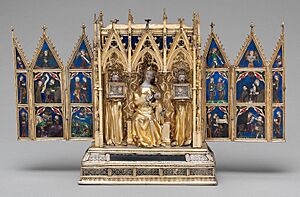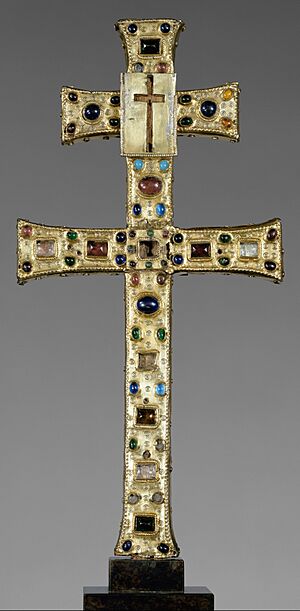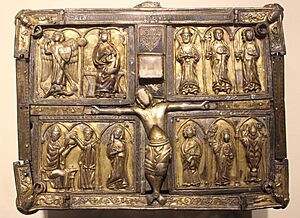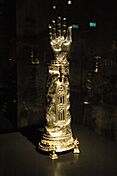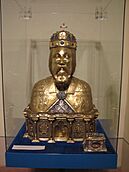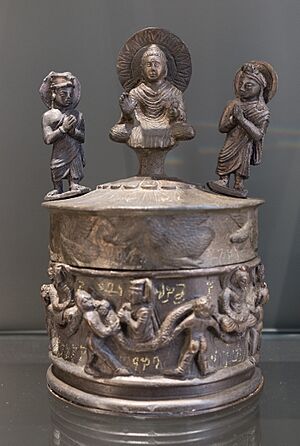Reliquary facts for kids
A reliquary is a special container that holds relics. You might also hear it called a shrine. If a reliquary can be carried, it's sometimes called a fereter.
What are relics? They are often believed to be physical remains of saints, like bones or pieces of clothing. They can also be objects connected to saints or other important religious figures. Sometimes, people debate if a relic is real or not. Because of this, some churches keep records to show where a relic came from.
Relics have been important to many religions for a long time. This includes Buddhists, Christians, and Hindus. These cultures often display reliquaries in special places like shrines, churches, or temples. People often travel to these places on pilgrimages to receive blessings.
Sometimes, the word "reliquary" is also used for containers holding body parts of non-religious people. For example, some kings of France wanted their hearts or other organs buried in a different place from their main burial.
Contents
Reliquaries in Christianity
Using reliquaries became a big part of Christian practices starting around the 4th century. This began in the Eastern Churches, which started moving and dividing saints' bodies earlier than Western churches. This was partly because the new capital city of Constantinople didn't have many buried saints, unlike Rome.
Relics are deeply respected in the Oriental Orthodox, Eastern Orthodox, Roman Catholic, and some Anglican Churches. Reliquaries help protect and display these important relics. They can be small, like pendants or rings, or very large, like elaborate boxes.
These containers were often made from or covered with precious materials. This included gold, silver, beautiful gems, and enamel. Ivory was also popular in the Middle Ages for reliquaries. Its pure white color showed the holy importance of what was inside. Making these objects was a major art form across Europe and Byzantium during the Middle Ages.
Many reliquaries were made to be portable. They were often shown in public or carried in special parades on a saint's feast day or other holy days. Many pilgrimages focused on showing respect for relics. People often show respect by bowing or kissing the reliquary. Churches that honor relics teach that this respect is for the saints, not the same as the worship given only to God.
In the 16th century, reformers like Martin Luther disagreed with using relics. They felt many relics didn't have proof of being real. They also didn't like the special honor given to saints. During the Protestant Reformation, many reliquaries, especially in northern Europe, were destroyed. They were melted down or taken apart to get the precious metals and gems.
However, reliquaries are still used and made today. This is especially true in Roman Catholic and Orthodox Christian countries. Reliquaries made after the Reformation often have glass sides. This allows people to see the relics inside, like the bodies of saints.
Different Kinds of Reliquaries
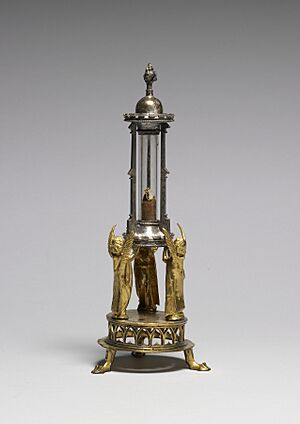
The first reliquaries were simple boxes. Some were just box-shaped, while others looked like small models of churches with pointed roofs. These church-shaped ones are called chasse. Typical examples from the 12th to 14th centuries had wooden frames covered with gilt-copper plaques. These plaques were decorated with colorful champlevé enamel. Limoges in France was a very important place for making these.
Relics of the True Cross (believed to be parts of the cross Jesus died on) became very popular from the 9th century onwards. These were kept in magnificent cross-shaped reliquaries made of gold and silver, decorated with enamels and precious stones.
From about the late 10th century, reliquaries also started to be shaped like the relics they held. For example, the skull of Pope Alexander I was kept in a reliquary shaped like a head. Similarly, saints' bones were often placed in reliquaries shaped like the body part they came from, such as an arm or a foot.
Many Eastern Orthodox reliquaries hold tiny pieces of relics. They have round or tube-shaped slots where small wax disks are placed, with the actual relic inside.
A philatory is a clear reliquary. It's designed to hold and show the bones and relics of saints. This type of reliquary has a window so you can see the relic inside. A feretrum was a medieval type of reliquary or shrine that held sacred statues and relics of a saint.
Later in the Middle Ages, the monstrance form was sometimes used for reliquaries. This form was mostly used for consecrated hosts (bread used in Christian ceremonies). These reliquaries held the relic in a clear rock crystal or glass capsule. This capsule was placed on a column above a base, allowing the relic to be easily seen by people. Around this time, reliquaries also appeared as large pieces of metal jewelry. These held tiny relics, like pieces of the Holy Thorn, such as the famous Holy Thorn Reliquary at the British Museum.
Reliquaries in Buddhism
In Buddhism, stupas are a very important type of reliquary. They can be buried inside larger structures like a stupa or chorten. In China and across East and Southeast Asia, these often look like a pagoda. In Japan, this is called a tō.
Two famous early reliquaries found by archaeologists are the 1st-century Bimaran Casket and the Kanishka Casket from 127 AD. Both are believed to have held parts of the ashes of Gautama Buddha after he was cremated. Relics associated with Buddha are the most important in Buddhism. However, relics related to other enlightened figures like Sariputta and Moggallana are also highly respected.
In Buddhism, relics are known as cetiya. One of the most important is the relic of the tooth of the Buddha in Sri Lanka. In Japan, Buddhist relics are called shari (shari (舎利, śarīra)). They are often kept in a shariden (shariden (舎利殿, relic hall, reliquary)).
See also
- Cetiya
- Relics of Sariputta and Moggallana
- Shrine of the Three Kings in Cologne Cathedral


